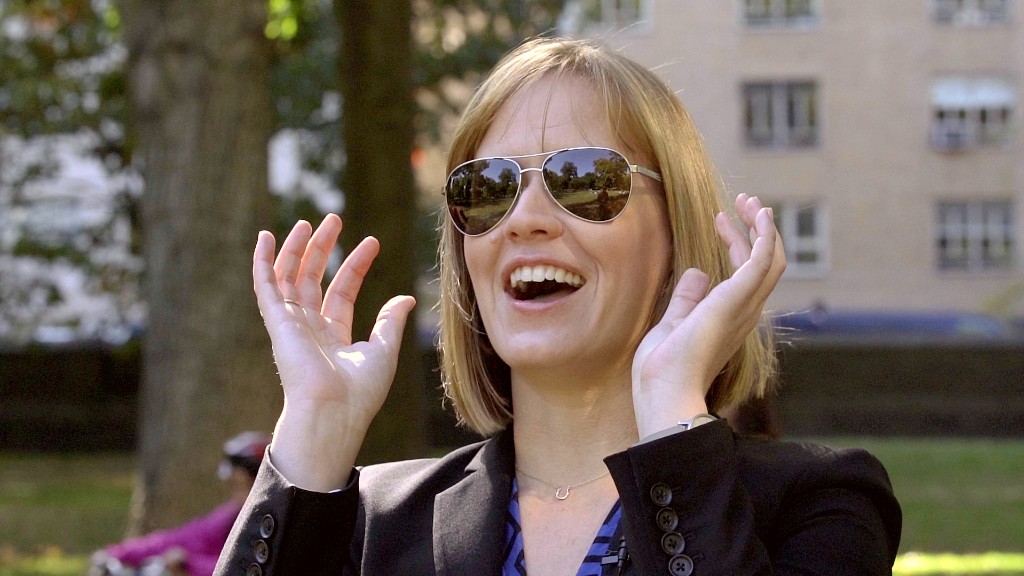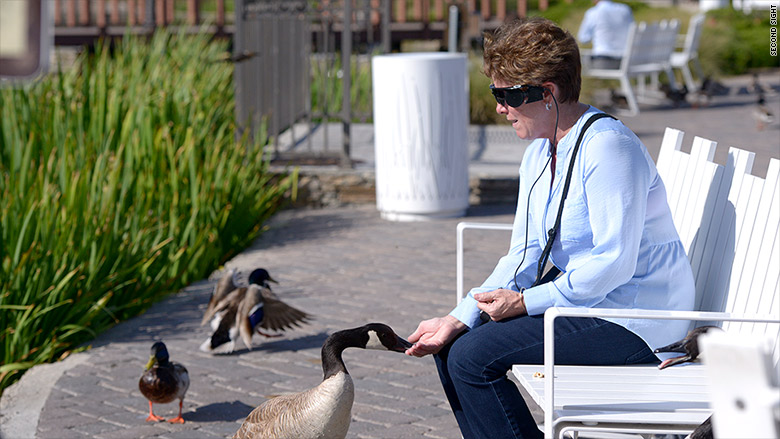
There is a chance that I may go blind someday.
I have a degenerative eye disease called retinitis pigmentosa, or RP for short. Still, I consider myself to be very lucky.
I recently turned 43, and I was diagnosed with RP when I was 16. But for now, my vision is mostly fine.
I have night blindness and my peripheral vision is not great. So I don't drive -- and I pay extra attention when walking around in order not to crash into things just outside my central field of vision.
But it could be a lot worse. Many RP patients my age have tunnel vision ... or are completely blind.
So when I noticed last week that shares of a small medical equipment company called Second Sight Medical Products (EYES) were surging, I was intrigued.
The company, which makes retinal implants, was featured on the most recent episode of "Vice" that appeared on HBO on Friday night. (HBO is owned by CNN parent company Time Warner.)
Shares of Second Sight started to skyrocket earlier in the week on the news that its Argus II technology would be one of several that Vice looked at in a segment of the show, called "Beating Blindness."
Related: Will humans be hybrids by 2030?
The stock was up nearly 60% for the week at one point and finished with a 22% gain.
I spoke with Will McGuire, the CEO of Second Sight, last week. He explained how the Argus II, which is being using mainly with RP patients for now, works.
A retinal surgeon attaches an electrode array to the eye that receives signals from a pair of glasses worn by the patient that are equipped with a video camera. Think of it as a bionic eye.
The camera captures video footage and transmits the images as series of electrical pulses to the eye that the brain then perceives as visual images.
The result isn't normal vision per se. Second Sight is not reversing any of the damage done to the retina.
But patients who were unable to see anything before using the Argus II are able to detect shapes and pick up contrast between light and dark.

The "Vice" reporter described it as "very very crude blips of light."
But that's a world of difference to someone who could previously see nothing.
"They can see a doorway. A window. I was with one patient in Italy who could read 3 or 4 letters in a row," McGuire said. "Someone who is blind can have more mobility, orientation and a connection to their surroundings. They can see fireworks explode."
McGuire said more than 170 patients have been equipped with the Argus II in the United States so far. The FDA approved it in 2013.
Second Sight is testing the Argus II on patients suffering from advanced macular degeneration too.
It's also working on a separate prosthesis called the Orion I for people who've gone blind from other conditions, such as glaucoma, diabetes or trauma that leads to a detached retina. The Orion I is currently in animal testing.
The Argus II device and procedure are costly though. Second Sight had been selling it for $143,000 -- although Medicare will now reimburse up to $95,000 for the implant and surgery.
Related: Candidates' plans for drug prices may miss the mark
As an RP patient, I'm excited by these technological advances. But as a person who makes a living by looking at numbers, I have to admit that the stock's runup on the Vice news last week was probably a bit overdone.
McGuire wouldn't comment about the stock's move. He said that Second Sight was excited to be profiled on "Vice" and that this was a big plus for the company. But he conceded that Second Sight has a "relatively small commercial footprint."
Second Sight, like many young healthcare companies, is losing money and spending a lot on research and development. The company will report its full year results on March 3.
But during the first nine months of 2015, Second Sight had total sales of $6.6 million and reported a loss of $14.5 million.
McGuire said the company recently announced a rights offering -- giving existing shareholders the ability to buy more stock at a discount -- and that Second Sight could raise as much as $20 million from the sale.
Related: Gadgets to make you a superhuman
Based on the company's current sales and cash burn rate, McGuire said the new capital should help get Second Sight through the end of 2017 before it would need more money.
Second Sight is one of several medical equipment companies and biotechs focusing on eye disorders to go public in the past few years.
But its shares, and others such as Glaukos (GKOS), Presbia (LENS), Ocular Therapeutix (OCUL) and Avalanche Biotechnologies (AAVL), have all fallen sharply since their IPOs.
I'm personally rooting for Second Sight. It's wonderful that people who are far worse off than I am are able to start seeing again -- even if it's on a limited basis. But while my heart tells me to buy the stock, my head is saying that it's way too risky.


